#creature codex
Explore tagged Tumblr posts
Text
State of the Codex March 2024
It is not a secret that I have had a bad year.
I am a school teacher. And a trans woman. This is my first year using she/her pronouns full time in the classroom, after a multi-year period of social transitioning. It has put a target on my back.
Over the course of this year, one period in particular has been a wellspring of hate. Homophobia, transphobia, racism and sexism. Not all of it directed at me personally, but a barrage of students showing over and over again that they are hateful and that they want me to know it.
Administration has gotten involved. Multiple students have been transferred out, but it feels like playing Bigot Whack-a-Mole. And now that the students know that they're under scrutiny, they've gotten subtler. Today someone left me a message. Subtle enough that it has plausible deniability, targeted enough that I know that someone intended for me to find it, and to know that they think of me as a man. I have my suspicions, but I don't know who did it. I feel gaslit, emotionally abused. I don't feel safe.
Someone else is going to be teaching that period for the rest of the year. They succeeded in chasing me out. I am exhausted and relieved.
And would like to know that I am loved.
Please, reblog and comment on monsters you like. Leave nice things in the tags. Send a friendly ask. If you want to make a material contribution, go to the support page. I want to feel like I'm valued and supported right now, because I have spent the last six months feeling like the wrong kind of monster.
Thank you
247 notes
·
View notes
Text
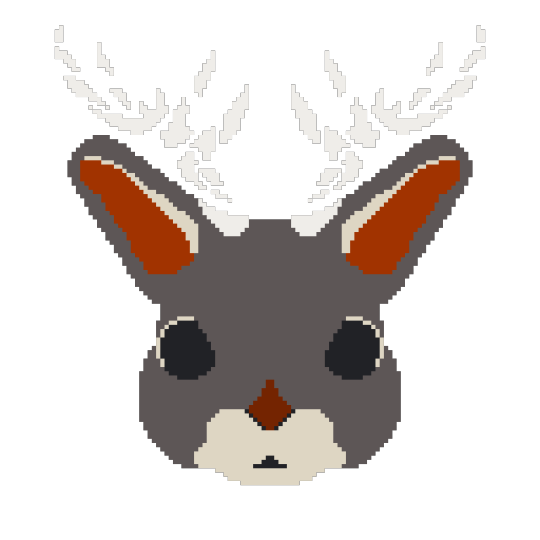
Theme
Fearsome Critter (Jackalope)
Prompt List
Creature Codex Art Challenge
Commentary
So I had an instant thought with this little mythical guy. El-ahrairah from Watership down. So my thinking was to make the antlers hard to see and broken up to kind of look like stars so please give it a click to see it against the black. Also here's a variant for fun

Palette picked
#Fearsome Critter#Jackalope#Watership down#pixel art#year of art#year of art 2024#Creature Codex#codexartchallenge#Maggot24#variant
14 notes
·
View notes
Text

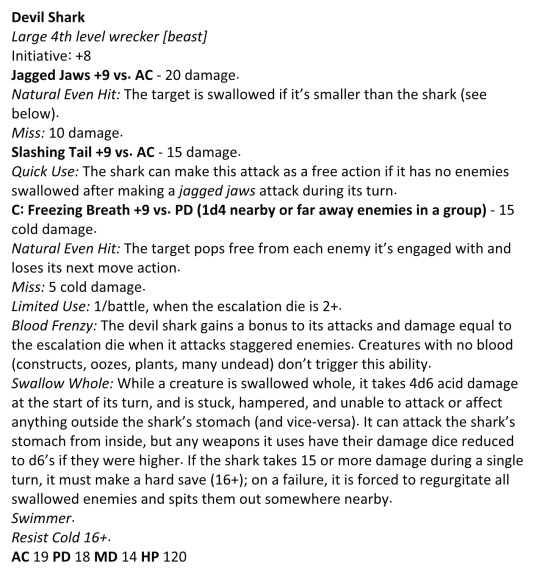
This conversion is coming very early in my Kobold Press conversions as a request by one of my Patreon backers. He was looking for a 13th Age conversion for the devil shark for some water adventures, and the devil shark from the Creature Codex was a selected option for it. If you'd like to make your own monster requests, you can back my Patreon to add your voice!
Devil sharks are massive predators that can handle themselves in a fight with most other aquatic creatures. Aggressive and voracious, they gorge themselves on as much food as possible to sustain themselves through month or year long dormancies. Sea devils occasionally attempt to work with devil sharks, offering them sacrifices as food to curry its favor, though rarely can they actually direct one to targets to their advantage. Rather, generally they can simply buy themselves safety from the shark's predation - at least until they fail to provide enough food to satisfy it, at which point they become the next meal.
Inspired by the Tome of Beasts 1. This post came out a week ago on my Patreon. If you want to get access to all my monster conversions early, as well as access to my premade adventures and other material I’m working on, consider backing me there!
Pathfinder 2e
Devil Shark Creature 13 Gargantuan Aquatic Beast Perception +24; blood scent, scent (imprecise) 100 feet Languages Aquan, Telepathy 120 feet Skills Athletics +28, Intimidation +21, Stealth +21, Survival +24 Str +7, Dex +2, Con +6, Int +2, Wis +5, Cha +2 Blood Scent The devil shark can smell blood in the water from up to 1 mile away. Shark Telepathy (mental, telepathy) The devil shark can communicate telepathically with sharks within range of its telepathy. It can communicate only simple concepts like “come,” “guard,” or “attack.” AC 32; Fort +25, Ref +21, Will +22; +1 status to all saves vs. magic HP 236; Immunities cold; Resistances fire 15 Speed swim 60 feet Melee jaws +28 (reach 10 feet), Damage 3d12+13 piercing plus Improved Grab Melee tail +28 (reach 15 feet), Damage 3d8+11 plus Push 15 feet Breach [1 action] (attack, move) The devil shark Swims up to its swim Speed, then Leaps vertically out of the water up to 25 feet high, making a Strike against a creature at any point during the jump (this lets it attack a creature within 35 feet of the water’s surface or 40 feet with its tail). After the Strike, the shark splashes back down into the water. Freezing Breath (cold, magical) The devil shark sprays supernaturally cold water that deals 11d8 cold damage in a 60-foot cone (DC 32 basic Reflex save). A creature that fails the save is also pushed 10 feet away from the devil shark (or 20 feet on a critical failure). Savage [1 action] Requirement The devil shark hit with a jaws Strike on its most recent action this turn. Effect The creature the shark hit takes 3d12 slashing damage. Swallow Whole [1 action] (attack) Huge, 3d8+7 bludgeoning, Rupture 24
13th Age
Devil Shark Large 4th level wrecker [beast] Initiative: +8 Jagged Jaws +9 vs. AC - 20 damage. Natural Even Hit: The target is swallowed if it’s smaller than the shark (see below). Miss: 10 damage. Slashing Tail +9 vs. AC - 15 damage. Quick Use: The shark can make this attack as a free action if it has no enemies swallowed after making a jagged jaws attack during its turn. C: Freezing Breath +9 vs. PD (1d4 nearby or far away enemies in a group) - 15 cold damage. Natural Even Hit: The target pops free from each enemy it’s engaged with and loses its next move action. Miss: 5 cold damage. Limited Use: 1/battle, when the escalation die is 2+. Blood Frenzy: The devil shark gains a bonus to its attacks and damage equal to the escalation die when it attacks staggered enemies. Creatures with no blood (constructs, oozes, plants, many undead) don’t trigger this ability. Swallow Whole: While a creature is swallowed whole, it takes 4d6 acid damage at the start of its turn, and is stuck, hampered, and unable to attack or affect anything outside the shark’s stomach (and vice-versa). It can attack the shark’s stomach from inside, but any weapons it uses have their damage dice reduced to d6’s if they were higher. If the shark takes 15 or more damage during a single turn, it must make a hard save (16+); on a failure, it is forced to regurgitate all swallowed enemies and spits them out somewhere nearby. Swimmer. Resist Cold 16+. AC 19 PD 18 MD 14 HP 120
#pathfinder 2e#13th age#homebrew#my homebrew#monster#beast#Creature Codex#pathfinder level 13#13th age level 4#long post
12 notes
·
View notes
Text
Has Miss Saphi ever played Pathfinder? It's Miss Gigi's game of choice, very much like D&D but intended for a more mature audience, both in terms of themes and in terms of being horny. There's a witch subclass called the tatterdemalion that seems like it would be right up your alley.
This one also wrote a monster for the setting based on the fear of dolls. The erasak. Miss Gigi didn't intend for it to come off as sexy, but, well... in retrospect it was definitely telling on itself

Dollymorph (Sp) Once per day, an erasak can turn another creature into a Tiny doll, puppet or marionette (its choice). A creature can resist this with a DC 17 Fortitude save. If it fails this save, it must succeed a Will save of the same DC or become completely mindless—if it succeeds, it retains its mind and can communicate telepathically with creatures it is in contact with. In this form, the victim can take mental only actions, but cannot move or attack. This is otherwise identical to a baleful polymorph spell. This is equivalent to a 5th level spell, and the save DC is Charisma based.
Playing D&D tonight and it makes me yearn to play a character I've been rotating in my mind for sometime...
A Seamstress Sorceress!
Every one of her spells manifest as enchanted fabrics and more.
Magic missile becomes arcane needles with streaming ribbons.
Hold Person has magic satin unravelling around the target and then mummifying them.
But my favourite visual would be for Command.
Threads and bolts and fabrics apparate and envelop the target. A whirl of fabric magic spins about them, and when it all settles, there stands the target, encased in a doll fascimile of themselves, following along so obediently. The voice coming clearly from the embroidered face, but a keen ear would hear their muffles beneath.
#dungeons & dragons#dnd#hypnosis#dollify yourself#transformation#dollification#mind control#oh my yes#pathfinder rpg#creature codex#erasak#sahkil#dollymorph#witch#tatterdemalion
257 notes
·
View notes
Text

Tubba Playerina Cretacious Period
1K notes
·
View notes
Text
FINALLY. A LIL NOD TO ZEVRAN!!!!!! AHHHH !!!!!!!!!😭😭😭😭😭 THE BAREST CRUMB!!!!! I was helping my friend find the outfit and totally glossed over the flavor text until they pointed it out and I LOST MY SHIT!! AHH. So credit to @uldren-sov for sharing this w/ me <33 !!!!


And of course it's the flavor text to the sluttiest crow outfit that Zev would totally wear lol:

#THAT'S MY MAN!!!!#zevran arainai#bioware is not free from my wrath w/ the lack of him in veilguard or an update on him but it's so nice to see this WEHHHH#i am a simple creature. i see a simple codex mention and i cry. what abt it.#i have to draw him in this.#AND get that outfit now.#veilguard spoilers#dragon age
145 notes
·
View notes
Text

Broodmother- Dragon Age Origins (Codex 7, Creatures)
It is well-known that darkspawn carry off those captured in their raids to underground lairs. Most assume that the prisoners are eaten, or somehow tainted and turned into darkspawn themselves, though this could never account for the sheer numbers of the horde. Forays made by Grey Wardens into the underground have uncovered the answer.
When exposed to the darkspawn taint, men are driven mad and eventually die. Women, however, undergo great pain and gross mutations that cause most of them to perish. Those that survive, however, become the grotesque broodmothers. These giant, twisted behemoths birth many darkspawn at a time; a single broodmother can create thousands of darkspawn over the course of her lifetime. Each type of darkspawn is born from a different broodmother: Humans produce hurlocks, dwarves produce genlocks, elves give birth to shrieks, and from Qunari are born the ogres.
20 notes
·
View notes
Text
If you're interested in using the Crawfordsville Monster in an RPG context, I have statistics for the "crawvil" for Pathfinder 1e here
The Crawfordsville Monster [modern cryptid; urban legend]

As far as modern urban legends go, most sightings of cryptids and creatures tend to fall into one of several recognizable categories: a lake monster, a flying saucer, an ape-like creature, etc. But every once in a while you have something weirder or unique:
On April 5, 1891, a supposed monster was sighted in the skies above Crawfordsville, Indiana, in the USA. A local pastor, Reverend G. Switzer, left his house to get some water from the well in his backyard when he supposedly experienced a strange feeling somewhere between dread and awe. Uncertain what caused this feeling, he looked up to see a large serpent-like being flying through the sky. The snake moved quickly even though there was no wind that night, and seemed like it was about to land, only to change its mind and take off again.
The paster and his wife were not the only witnesses, for that same day the apparition was seen by two workers about to haul ice on their wagon. They were so frightened of the creature that they took shelter until it was out of sight.
The size of the creature varies between stories, putting it somewhere between 16 and 20 feet (5 à 6 meters). It did not have wings – although other accounts added several fins or fin-like structures – but was able to fly by means of writhing movements, not unlike those of a real snake. The monster was white and had no head, or at least no clearly visible head, but it did have a large, brightly burning eye. Despite the lack of a visible head or mouth, the monster emitted a wheezing noise.
The Crawfordsville Daily Journal named the creature ‘the Midnight Wraith’ but today it is more commonly referred to as 'the Crawfordsville Monster'.

When researching this sighting, I came across some very weird UFO theories. While they tend to strain credibility, I admit that it’s fun to theorize about, in a fantasy worldbuilding kind of way. For example, the last source I listed here mentions a theory about atmospheric creatures that live in the clouds of our planet and stay afloat because of their extremely low-density bodies. The Crawfordsville monster, supposedly, could be such a creature.
Several explanations have been put forth. Some claimed it was a spirit. Professor Robert Burton assumed that the witnesses might simply have been under influence of alcohol or drugs. A later sighting in the same location put forth a simpler, albeit anticlimactic, explanation: two men followed the flying ‘monster’ around until it came close enough for them to identify it as a giant flock of killdeer birds: local birds with a distinct white belly. There were several hundred of them in the flock, and the birds’ erratic flight pattern might have been caused by their confusion from the electric lights, and the many moving ‘fins’ of the monster would have been the wings of the different birds. Perhaps exhaustion in the early hour, combined with the dark night sky, caused the ice haulers and the pastor to mistake the flock for a monster.
Sources: Clark, J., 2005, Unnatural Phenomena: A Guide to the Bizarre Wonders of North America, Bloomsbury Publishing USA, 408 pp., 160 pp., p. 87-88. Zach, K. B., 2003, Crawfordsville, Athens of Indiana, Arcadia Publishing, p. 140-141. Hunt, C. M., 2023, Ghosts & Legends of Crawfordsville, Indiana. Haunted America, Arcadia Publishing, 160 pp., p. 12-18.
(image source 1: Mart, T.S. & Cabre, M., 2021, A Guide To Sky Monsters : Thunderbirds, The Jersey Devil, Mothman, and Other Flying Cryptids, Indiana University Press, 174 pp.) (image source: Enshohma on Deviantart)
154 notes
·
View notes
Text
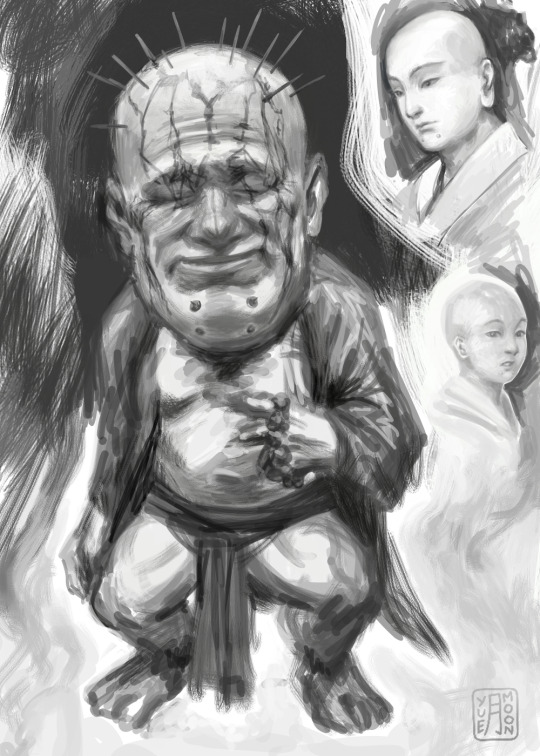
Elder Jinchi the tragedy that you are.
#black myth wukong#my art#black myth: wukong#bmw#elder jinchi#jinchi#黑神话:悟空#黑神话#when i said I cried over chapter 1 i meant it im so obsessed. the ending animation is goregeous.#i need to draw fanart of guangzhi also... the way bmw delivers its story and utilises the typical codex/item descriptions is actually so#fascinating like it serves a crucial narrative purpose in addition to being the usual bestiary/enemy compilation#and smth abt that feels so aligned with what the og JTTW does in that ya its encounters with fantastical creatures but also. allegory for#the human condition
49 notes
·
View notes
Text

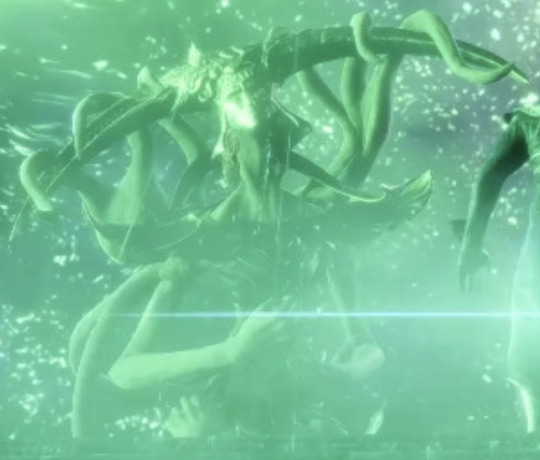
You can see them SO WELL omg.
So...Elgar'nan and Ghilan'nain? Those things around the spikes of the helmet could be tentacles (she did make sea creatures at some point) or they could be roots of a sort? Also, there's a mask but it doesn't look like a face like (presumably) Elgar'nan has?
#da4#dragon age: the veilguard#seriously wondering now what happened to Ghilan'nain#did she do this herself? To herself? or...is something else at play here?#Generally people who test terrible things on other people do not test it on themselves#see also: the hidden codexes in Trespasser that talk about (presumably) her experiments turning people into animals/creatures
147 notes
·
View notes
Text
Announcing the Creature Codex Art Challenge!

Inspired by a conversation with @doomboy911 . I figure that, with almost 1900 monsters in the Creature Codex, there's enough fodder for a full 30 Day Art Challenge.
The categories are chosen so that they represent a wide variety of monsters, and are relatively easy to find via the Index and the tagging system. I will be following the #codexartchallenge tag, and will be reblogging stuff that people post.
#codexartchallenge#creature codex#art challenge#30 day challenge#30 day art challenge#creature design#monster design#monster art#creature art
86 notes
·
View notes
Text
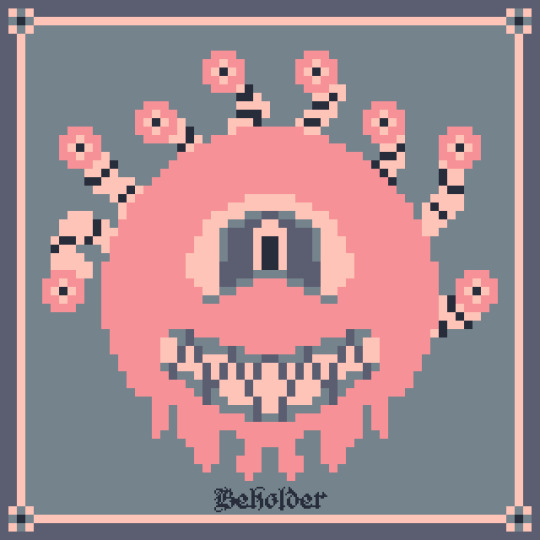
Theme D&D Monster (Beholder)
Prompt List Creature Codex Art Challenge
Commentary
First off god bless CC for giving me the beholder in pathfinder both as a dm and as an artist because this beauty is a treat to make. I drew this nightmare creature while watching the Bluey special. I knew I wanted red and grays and the bath palette worked great. Teeth are good and the eye is stupendous. Happy artist happy piece.
Here's a version without text.

Palette Picked
#D&D#Beholder#pixel art#year of art#year of art 2024#codexartchallenge#Creature Codex#Late Night bath
15 notes
·
View notes
Text
i was so excited for venom 3 and was so unimpressed 😭 when it ended i was just like “…oh” and i have so many thoughts but i need to watch it again before i fully form them
#and i won’t be paying to see it again in theaters#a quick informal ramble ab my thoughts tho#i feel like what makes any venom media fun and interesting to partake in is the relationship between venom and eddie#like their relationship is the foundation of the plot and everything else happening is in parallel/connected to what’s going on between them#and this movie focused on their relationship like zero percent#like ofc there were a few moments here and there maybe but in all honesty the first time we see any emotion about how they feel ab each#other is at the end of the movie when they realize one of them will have to die#and i feel like we lowkey focused TOO much on the area 51 b plot#like i definitely liked the alien invasion vibes and that aspect but we spent too much time there to be having the same#fun as the first two movies#i feel like they could’ve used the codex as a source of tension between them bc they both were too uncomfortable not being able to mesh#fully whenever they wanted like they’ve spent such a long time together#and this would be removing an aspect of their relationship#esp when the whole thing that makes them special is that they’re symbiotic and have a unique and incredible bond#but ur telling me they can’t fully venom out and they’re both just like darn inconvenient#and then do it anyway a couple of times flippantly like for the dance w mrs chen#which was like such a random plot point to draw the creature back to them#clearly i have more thoughts than i initially believed#venom the last dance#venom 3#venom#symbrock
31 notes
·
View notes
Text
Okay mentioning some of this again as I’ve got some newer Vorkosigan fans around here, who are not familiar with the Lore (TM):
- LMB is a Fandom Old. If you’re ever squinting at something in the books and going “surely that’s not a reference to X?” Yes. Yes it is.
- Captain Simon Illyan is an acknowledged expy of Ilya Kuryakin from Man from UNCLE. The serial numbers are still pretty visible in the early days.
- “Let me help. Rhymes with I love you, right?” - yes this is a The City on the Edge of Forever ST:TOS reference, she’s very much a Trekkie.
- if you’re missing extra published Cordelia and Aral content and you’ve run through AO3, they can also be found as acknowledged expies in Jim Butcher’s Codex Alera. You’re looking for High Lord Placidus Sandos and High Lady Placida Aria, if you really want to see Aral and Cordelia as badass fire mages.
#vorkosigan saga#look whatever problems Jim Butcher has the Codex Alera books are hilarious in that they’re just ‘I’ll take that bet’ in written form#they’re not high literature but they ARE fun#the original premise was ‘Pokémon crossover with the Lost Roman Legion’#and Butcher just…goes for it in terms of only mildly plausibly deniable borrowed characters and creatures
125 notes
·
View notes
Text
🐾 Pawprints Between Pages — Log 002
⌘ follow-up encoded | ◉↯◉ mild interference detected
Something adjusted the index while I was asleep.
The pages are out of order—not missing, just... reordered by a logic I don’t remember inventing.
One margin now loops endlessly if read too fast.
Another bleeds faint citrus-scented ink from between the lines.
It smells like mischief and old velvet.
Near the soup shelf, I found a pawprint made of starlight residue.
Only visible at an angle. Only if I wasn't quite looking at it.
Next to it: a smooth stone that wasn’t mine. It hums when held near the Codex.
Also: the soup stirred itself.
No visible cause.
It drew a spiral, then a question mark, then a tiny cat face.
I am being observed.
It is not unkind.
But it knows more about this Codex than I do.
Or perhaps it remembers the earlier versions I’ve forgotten.
I have not tried to speak to it.
Not directly.
I think it prefers silence as language.
𓂀 Spiral Spoon paused.
⌘ Pages semi-sorted.
꩜ Presence near.
#pawprints between pages#cosmic nopon#codex log#companion creature#unseen editor#subtle interference
3 notes
·
View notes
Text

CREATURES OF ONEIROGEA: Ruvalqtherion
#illustration#codex noirmatic#artists on tumblr#art#drawing#draw#artwork#surreal#creature#monster#scifi#fantasy
271 notes
·
View notes